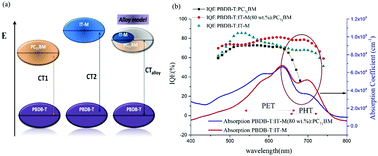The role of balanced dual charge generation pathways in ternary organic solar cells†
Abstract
Efficient charge generation and transfer are crucial for organic solar cells (OSCs) to achieve high power conversion efficiency (PCE). The ternary strategy is commonly used to expand the absorption range of the device by utilizing complementary absorptions of three materials. However, the role of balanced electron transfer and hole transfer in ternary OSCs is rarely reported, although it is essential to improve the performance of the device. Here, we achieved balanced photoinduced electron transfer (PET) and photoinduced hole transfer (PHT) processes in PBDB-T:PC71BM:IT-M ternary OSCs, which is identified by the absorption, internal quantum efficiency (IQE) and photoluminescence (PL) quenching measurements. In addition, the VOC of ternary OSCs is found to increase with an increase in the ratio of IT-M, which is in good accordance with the “alloy model”, as revealed by the increased ECT estimated from the EL measurements. The enhanced PHT from IT-M to PBDB-T is supposed to be a result of the improved blend film phase morphology and material crystallization of the active layer under the optimal condition, as revealed by the GIWAXS and TEM studies. Thus, the charge generation and transportation of the ternary device are improved, increasing the JSC and FF of the devices. The findings here are of great importance to understand the origin and role of balanced dual charge generation pathways in ternary OSCs, providing potential methods to further improve the performance of materials and devices.



 Please wait while we load your content...
Please wait while we load your content...